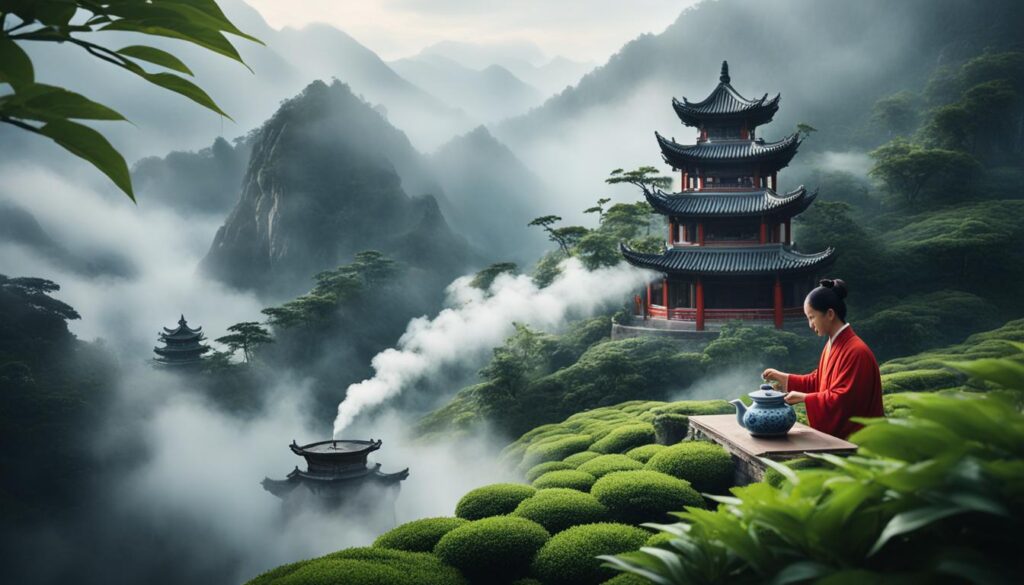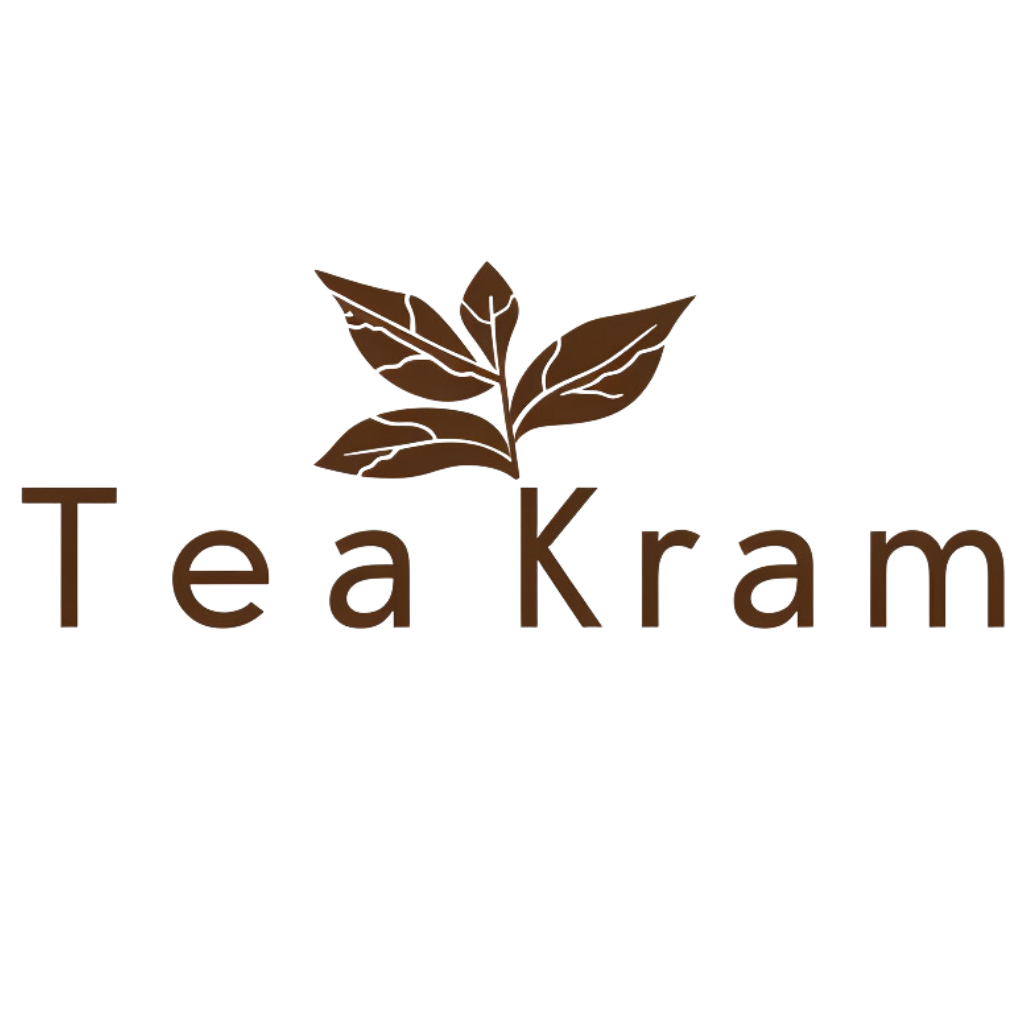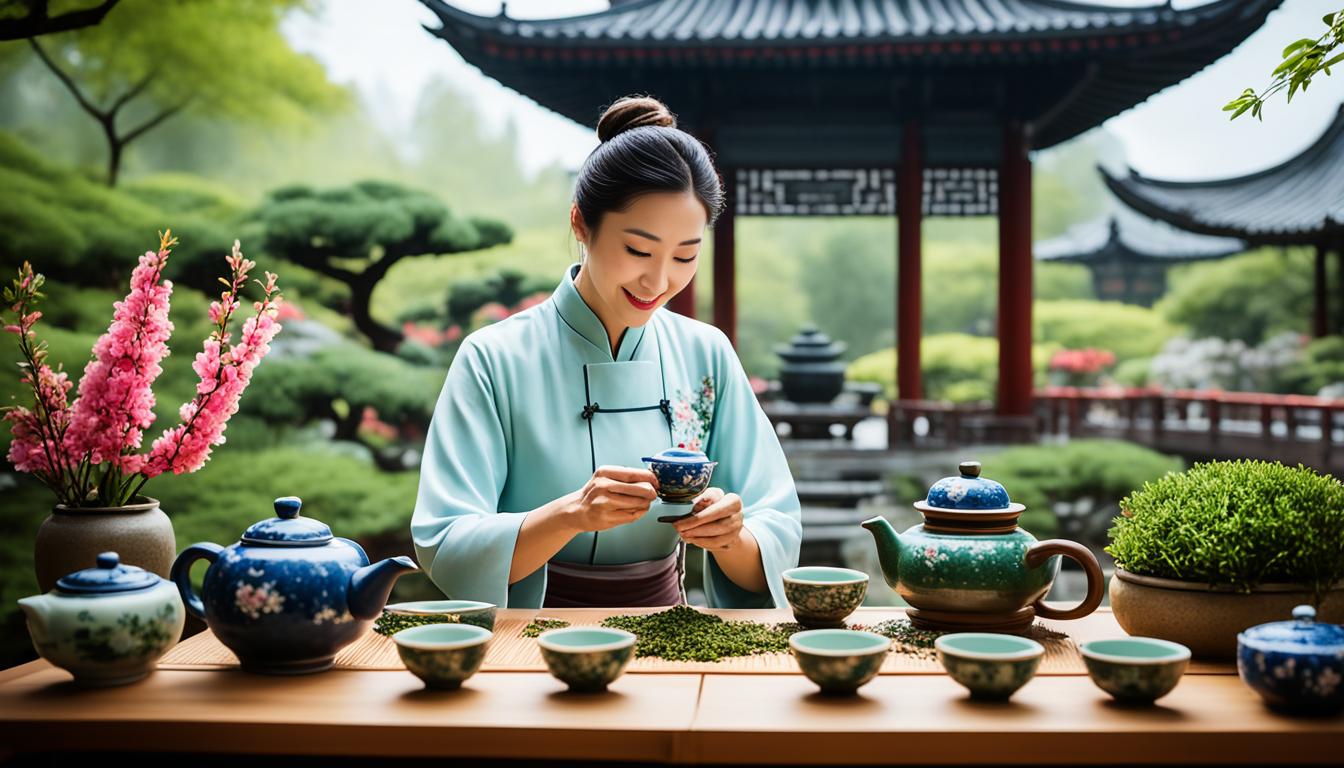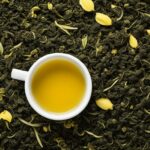The tapestry of Chinese tea history is as rich and vibrant as the Chinese tea culture itself. An elixir that has transcended mere consumption to become a cornerstone of spirituality, social etiquette, and healing – the journey of tea in China is an evocative chronicle of both nature and human ingenuity. Delving into the tea traditions in China offers a glimpse into an ancient tea culture that has matured and flourished over millennia. Each sip unlocks stories of emperors and commoners, of monks and merchants, all united by this subtle yet profound beverage.
Across the emerald expanse of Chinese landscapes, legends whisper of tea’s divine origins, as ancient as the soil from which they spring. In these legends, the fabric of society is interwoven with a reverence for tea, embedding it within the hearts of the people as a symbol of harmony and wisdom. It is not simply a thirst quencher but a medium through which one can experience the soul of China’s past and present.
Join us on an aromatic voyage to the regions famous for tea in China, where every hill and valley tells a unique tale. From the mist-shrouded mountains of Yunnan to the serene waters of West Lake in Hangzhou, each distinct tea echoes the essence of its birthplace, carrying within it an inheritance of flavor and fragrance that continues to enchant the world.
Key Takeaways
- The enduring legacy of Chinese tea history is woven deeply into the cultural fabric of China.
- Tea traditions in China are not just practices but are emblematic of broader philosophical and spiritual views.
- Tracing these traditions offers insight into the ancient rituals and the societal importance placed on tea through the ages.
- Regional teas carry the identity of their native lands, marked by distinct flavors that reflect the diversity of China’s geography.
- Tea legends in China serve as both educational and inspirational narratives that continue to influence tea cultivation and enjoyment today.
- Exploring Chinese tea culture is an immersive experience, offering a taste of the country’s rich history and regional specialties.
The Ancient Roots of Chinese Tea Culture
The narrative of Chinese tea is immensely rich, offering a window into an era where tea was more than a beverage—it was a bridge to spirituality and a marker of societal status. Delving into this heritage uncovers the profound significance tea held in the ancient Chinese way of life, resonating through centuries to influence the modern world.
Tracing the Origins of Tea Traditions in China
Tea traditions in China are steeped in a history that dates back to the venerable Shang dynasty. The practice of cultivating and consuming tea has been meticulously documented, reflecting its pivotal role in Chinese society. These traditions laid the groundwork for what would become a cornerstone of Chinese culture, resonating in every cup enjoyed today.
Ancient Tea Culture in China: A Legacy in Leaves
The solemn Chinese tea ceremony, with its roots in Taoism and Buddhism, encapsulates the intersection of art, philosophy, and the act of drinking tea. Each gesture within the ceremony is a tribute to the deliberate pace of nature, encouraging a meditative state and facilitating a deeper connection within the community and self.
Myths and Legends: Tea Lore in Chinese History
Tea legends in China are as robust as the history of the tea itself, with characters such as Emperor Shennong, whose mythical discovery of tea paints a folklore rich with wonder and serendipity. These legends have elevated the status of tea to one of divine providence, underscoring its valued place within Chinese culture.

| Legend | Origin | Significance |
|---|---|---|
| Emperor Shennong | Mythical | Discovery of Tea |
| Bodhidharma | Tang Dynasty | Association with Zen Buddhism |
| The Classic of Tea | Tang Dynasty | First definitive work on cultivating and preparing tea |
Inspired by the past, the tea traditions in China continue to thrive, inviting participants to not only partake in the ancient legacy of tea but to continue weaving the tale for generations to come.
Tea Cultivation and Regional Varietals in China
Immerse yourself in the verdant fields where the virtues of patience and precision yield the world’s most venerated brews. The process of tea cultivation in China is a fine art refined over countless generations, encapsulating the essence of a rich agricultural landscape. With methods passed down through the ages, each leaf whispers a story of the soil, the climate, and the spirit of the land from which it hails.
The Art of Chinese Tea Cultivation
The Chinese tea leaf, in its journey from soil to sip, undergoes an alchemy that is as much the province of the cultivator as it is of nature. The meticulous stages of nurturing, picking, and processing are acts steeped in tradition, pivotal to creating the delicate balance of flavors sought by tea connoisseurs the world over. The age-old craft of shaping tea in China into its myriad forms is reflective of the country’s deep-seated reverence for this timeless beverage.
Exploring Regions Famous for Tea in China
From the ethereal mists of Hangzhou’s West Lake to the dusky soils of Yunnan, Chinese tea embodies the characteristics of the lands that beget them. Each region boasts its own signature brew, a sensory imprint of its native terrain. The exquisite Dragon Well green tea of Hangzhou, the earthy Pu-erh of Yunnan, and the sumptuous Oolong from the Wuyi Mountains are but a few of the types of tea in China that distinguish themselves on the global stage. These regions famous for tea in China tell a tale of harmony between man and nature, culminating in flavors complex and sublime.
How Geography Influences the Types of Tea in China
More than mere geography, the intricate interplay of altitude, climate, and soil composition imbue Chinese teas with an extraordinary depth of flavor. It is this mosaic of environmental factors that bestows each tea with its singular identity, a symphony of aroma and taste that is both an expression of the terrain and a testament to the artisan’s skill. In these natural nuances and nuances, the profound diversity of tea in China finds its roots, a poignant reminder of the land’s bounty and the timeless rituals that celebrate it.
FAQ
What role does history play in Chinese tea culture?
The history of tea in China stretches back thousands of years and is deeply interwoven with the country’s cultural and spiritual practices. From ancient emperors to the everyday people, tea has been a pivotal aspect of social rituals, medicinal practices, and daily life. Throughout Chinese history, tea has carried symbolic significance, representing wisdom, virtue, and a medium for social bonding and reflection.
How did ancient Chinese tea culture originate?
The origins of ancient Chinese tea culture can be traced back to the Shang dynasty, with tea consumption evolving significantly during the subsequent dynasties. Historical anecdotes attribute the discovery of tea to Emperor Shennong, and its evolution was closely linked with Taoist and Buddhist philosophies, giving rise to the Chinese tea ceremony as a meditative and communal practice.
Can you explain the significance of the Chinese tea ceremony?
The Chinese tea ceremony is more than a method of tea preparation; it is a spiritual and aesthetic expression that emphasizes mindfulness, precision, and harmony. The ceremony is imbued with philosophical meanings, offering a tranquil respite from the daily hustle, facilitating social connection, and creating a bridge between humanity and nature. It is a ceremonial ritual that celebrates the art of tea through graceful gestures and peaceful environment.
What legends are associated with Chinese tea?
Numerous legends and myths are part of the storied past of Chinese tea. The most famous is the legend of Emperor Shennong, who purportedly discovered tea’s beneficial properties when leaves from a wild tree drifted into his boiling water. Tea in Chinese folklore is often symbolized as a gift from the heavens, imbued with the power to cleanse the mind and soul, and is frequently featured in tales of scholars and sages.
Which regions in China are renowned for their tea production?
China boasts a number of regions famous for their tea production, each offering unique varieties. Notable among them are the West Lake region of Hangzhou, known for its exceptional green teas like Longjing, and the mountainous Yunnan province, celebrated for its rich and earthy pu-erh teas. Other prominent regions include Fujian, which produces the famous oolong teas, and Anhui, known for the historic Keemun black tea.
How does geography influence the types of tea produced in China?
Geography plays a crucial role in determining the characteristics of the various types of tea produced in China. The climate, soil composition, and altitude all impact the quality and flavor profile of the tea leaves. For instance, the misty mountains and cool climate of the Fujian province are ideal for the growth of oolong teas, while the humid and warmer regions of the south promote the lush growth suitable for black and pu-erh teas. Each geographic area lends its distinct terroir to the teas, thereby creating a diverse spectrum of flavors and aromas that is celebrated in Chinese tea culture.
What is the art of Chinese tea cultivation?
The art of Chinese tea cultivation is an intricate process that combines time-honored agricultural traditions with careful attention to detail. This includes selecting the perfect terrain, understanding the optimal harvesting periods, and mastering the art of processing tea leaves, whether they’re being pan-fired, rolled, oxidized, or fermented. The dedication and skill of tea farmers and artisans contribute to the high quality and distinctive characteristics of Chinese teas.



